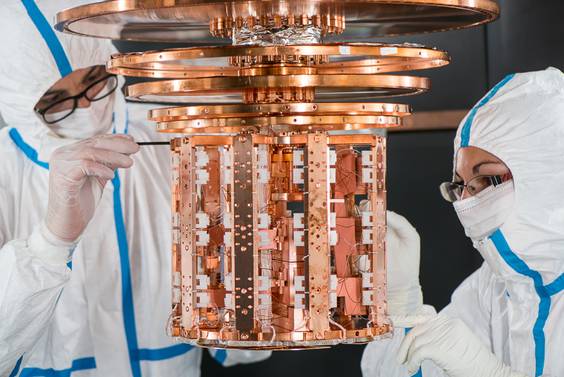28.09.2016
The search for dark matter: Entering the next phase of CRESST
The CRESST experiment is continuing its search for dark matter. A few weeks ago the detector reached its operating temperature of around -273 degrees Celsius, i.e. close to absolute zero. For the new measurement started in September, the experiment has been fundamentally overhauled: among other things, a novel type of detector is now being used. In future, CRESST will be able to search for very light dark-matter particles – in a mass range which is currently not covered by any other experiment.
The CRESST experiment has recently started a new measurement run; the last one ended in August 2015. At that time, it turned out that some of the detectors were highly sensitive to very light dark-matter particles. This prompted the scientists to upgrade all detector modules.
Greater search range for dark-matter particles
The new sensors reduce the energy threshold for particles of dark matter. “During the last measurement phase, CRESST advanced into a very low energy regime down to 300 electronvolts,” explains Federica Petricca, scientist at the Max Planck Institute for Physics and spokesperson for the CRESST research collaboration.
“In the future we will be able to detect particles that are much lighter than a gigaelectronvolt.” This mass regime agrees with more recent theoretical models which predict very light dark-matter particles.
Overall, the search area for particles of dark matter will expand significantly. All current experiments together cover a spectrum from very light to very heavy particles: from less than a gigaelectronvolt (CRESST) through to several 100 gigaelectronvolts (Xenon 1T).
The overhauled CRESST experiment
The CRESST experiment uses crystals of calcium tungstate (CaWO4). As the expected collisions between the particles and the atoms in the crystal are extremely rare, it is crucial to avoid interference signals as much as possible. In order to reduce the radioactive background originating from the crystal itself, CRESST exclusively uses high-purity crystals produced in the crystal lab at the Technical University of Munich.The lab is located in the underground lab of the Physics Departement, financed by the Excellence Cluster Universe.
The mountings for the crystals have been optimized as well – they are also now equipped with sensors. “We can thus determine exactly where in the detector particle interactions occur and distinguish dark-matter signals from background sources,” explains Petricca.
CRESST expects the first results from the recently-started measurement in about a year. The group is also working on further reducing the threshold for light dark-matter particles. “The ultimate goal is to expand the search region even further – and thus track down the mystery of dark matter,” says Petricca in conclusion.
Participants in the CRESST collaboration include the Max Planck Institute for Physics, the University of Oxford, the Technical University of Munich, the University of Tübingen, the Institute of High Energy Physics in Vienna, the Vienna University of Technology, and the Gran Sasso National Laboratory of the Istituto Nazionale di Fisica Nucleare in Italy. The work was funded by the German Research Foundation (DFG; via Cluster of Excellence Origin and Structure of the Universe), the Helmholtz Alliance for Astroparticle Physics (HAP) and the German Federal Ministry for Education and Research (BMBF).
Further Information on CRESST:
- Website of the CRESST experiment: www.cresst.de/
- Article on the CRESST experiment in the TUM science magazine „Faszination Forschung“: https://portal.mytum.de/pressestelle/faszination-forschung/2012nr11/index_html
- The CRESST experiment at the Max Planck Institute for Physics https://www.mpp.mpg.de/forschung/experimental/cresst/index.html
- Video on the CRESST experiment (YouTube) https://www.youtube.com/watch?v=X_Xwk7xztZE
Kontakt:
Prof. Dr. Stefan Schönert
Technische Universität München
James-Franck-Str. 1
D-85748 Garching
Tel.: +49 89 289 12511
E-Mail: schoenert@ph.tum.de
Dr. Federica Petricca
Max-Planck-Institut für Physik
Föhringer Ring 6
D-80805 München
Tel.: +49 89 32354 309
E-Mail: petricca@mpp.mpg.de






